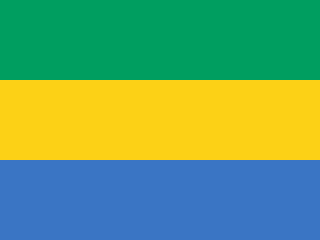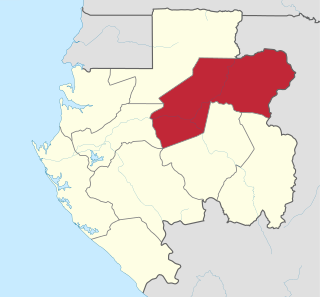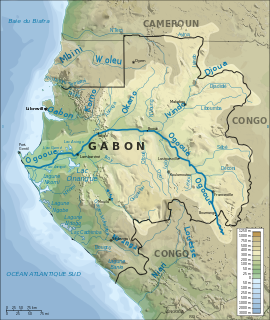
Mékambo is a small town in north-eastern Gabon on the banks of the Zadié river. It is located in the Ogooué-Ivindo province of Gabon and is the seat of the Zadié Department. It has received international press for recent outbreaks of Ebola hemorrhagic fever in 1994 and 1997.
The Ivindo River is the most important tributary of the Ogooué River, which flows in Gabon.

The Ogooué-Lolo Province is one of the nine provinces of Gabon, slightly southeast of central Gabon. The regional capital is Koulamoutou, a city of approximately 16,000 people. It is the ninth largest city in Gabon and the home of slightly more than one-third of the provincial population.
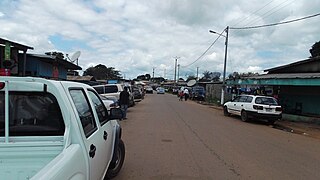
Lambaréné is a town and the capital of Moyen-Ogooué in Gabon. With a population of 38,775 as of 2013, it is located 75 kilometres south of the equator.

The Trans-Gabon Railway is the only railway in Gabon. It runs 670 km east from Owendo port station in Libreville to Franceville via numerous stations, the main ones being Ndjolé, Lopé, Booué, Lastoursville and Moanda.

Ndjolé is the capital town in the Abanga-Bigne Department in Gabon, lying northeast of Lambaréné on the Ogooué River, the N2 road and the Trans-Gabon Railway. It is known as a base for logging and as a transport hub. Ndjolé is the last city that can be reached by barge traffic traveling up the Ogooué River. Above Ndjolé there are rapids on the river.

Haut-Ogooué is the southeastern-most of Gabon's nine provinces. It is named after the Ogooué River. It covers an area of 36,547 km². The provincial capital is Franceville. One of its primary industries is mining, with manganese, gold and uranium being found in the region. The uranium-bearing mineral Francevillite takes its name from the primary city. It is the historical home of three cultures, the Obamba, Ndzabi and Téké. Like many regions in Africa, more traditional uses of the land have given way to rural migration to the larger cities. In August 2006, its soccer club won the Gabon Independence Cup.

Moyen-Ogooué is one of Gabon's nine provinces. It covers an area of 18,535 km2 (7,156 sq mi). The provincial capital is Lambaréné.

Ngounié is a province of south-central Gabon covering an area of 3,775 kilometres (2,346 mi). Its capital is Mouila. At the 2013 census it had 100,838 inhabitants. In 2016, its governor was Benjamin Nzigou.
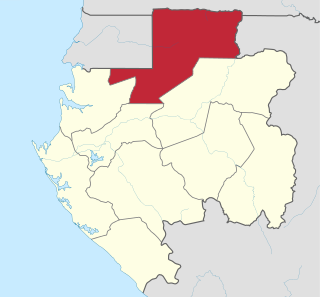
Woleu-Ntem is the northernmost of Gabon's nine provinces. It covers an area of 38,465 km² and named after Woleu and Ntem rivers that cross it. The provincial capital is Oyem, which had a total of 60,685 inhabitants in 2013.

The provinces of Gabon are divided into forty-nine departments. The departments are listed below, by province :
The Batéké Plateau is located around the border between the Republic of Congo and Gabon. In both countries it gave name to departments:

Zadié is a department of Ogooué-Ivindo Province in northern-eastern Gabon. The capital lies at Mékambo. As of 2003 the department had a population of 15,203 people. The department has a population of Bakoya pygmies, settled here since about 1933 along the main roads from Mékambo to Mazingo and Mékambo to Ekata on the Congolese border. The area received international press for outbreaks of Ebola hemorrhagic fever in 1994 and 1997.
Shiwe, also known as "Fang Makina", is a Bantu language of central Gabon, near the related language Yambe. It is most closely related to Kwasio. The Gabonese people who refer themselves as Shiwe or Bishiwe live in the city of Booué in the Ogooué-Ivindo province. There are no accurate statistics available for the Shiwe population in Booué. However, there are about 18 Shiwe tribes still living in Booué today. These tribes include Bi-mbouma, Bira-ngouembi, Bi-néli, Sha-ntouong, Sha-nguié, Bi-nshwô, Bi-shanga, Bi-kwo, Bi-tsinguie’rg, Sha-shouo, Bi-nvœ’rg, Bi-koundeu, Biong-nkouendi, Bi-ntoubi, Biékoulembi, Bi-nzimili, Bi-nyambi, Sha-tsoung. These tribes live in 5 villages including Beleumeu, Menchoung, Metououng, Beaux Arts, and Tsombiali. It is important to underline that there are entire Shiwe tribes and villages near Makokou and Ndjole. But these originally Shiwe tribes are now increasingly using more the Fang language than Shiwe.
The Bakoya are pygmies, earlier known as Négrilles or Babinga, who inhabitant the rainforest between Cameroon and the Great Lake region of the Congo Basin in Central Africa. Since the 1930s, the Bakoya, in particular, have settled in Gabon in the Ogooue-Ivindo Province, in the northeastern region of the country. Similar minority groups are the Babongo and the Baka pygmies. Before they adapted to the agricultural practices in the new settlements in Gabon along the flanks of the road, Bakoya were “semi-nomadic hunter-gatherers” like the other forest-dwelling pygmies; they resided in small huts. The word 'Pygmee' is a French coinage, adopted by the Gabonese. They are the earliest inhabitants of the forest and are nomadic hunter gatherers.

Booué Airport is an airport serving the town of Booué in the Ogooué-Ivindo Province of Gabon. The runway lies within a bend of the Ogooué River.
The Okandé are a people of north-eastern Gabon who belong to the Mèmbè language group. Their language overlaps that of the Apindzi and the Simba about 80/86% according to professor Van Der Veen. Their estimated population of 2,000 persons live in the Lopé region in Ogooué-Ivindo. The Mwiri, a male initiation institution, still plays an important role in the traditional social and religious life of the Okandé.

